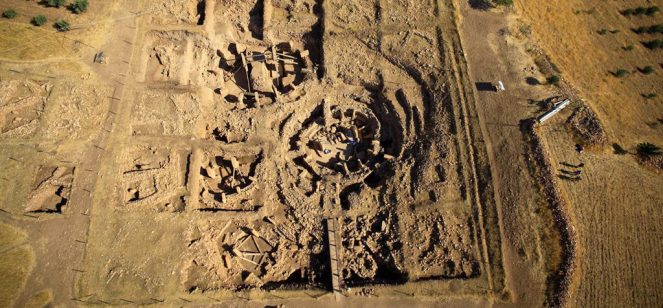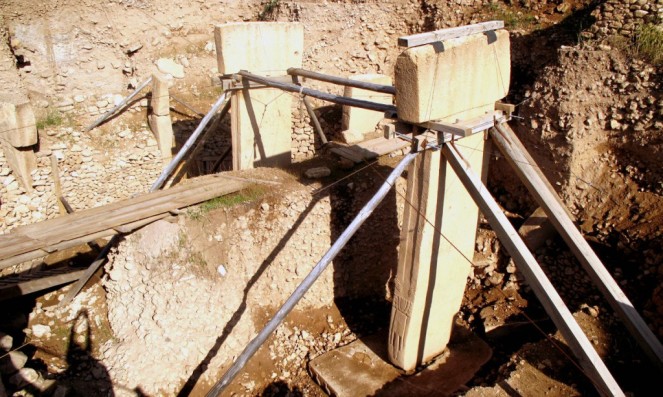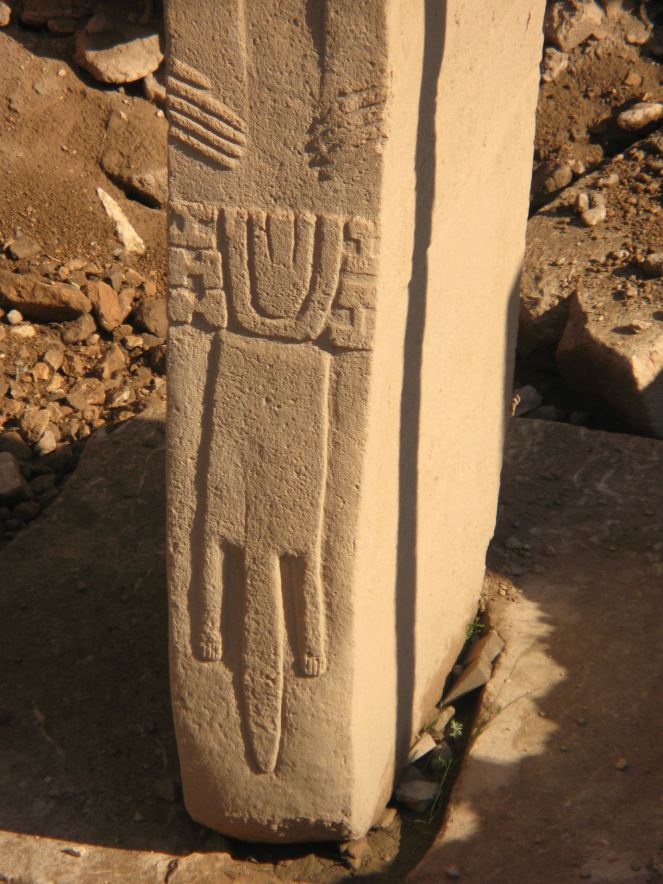The stone age temples dug into a hill near Sanliurfa in Turkey are causing a storm. It’s not often we find something that overturns everything we know, but Gobekli Tepe is a genuine mystery. Archaeology and history are being rewritten. Not that you’d know about it. The discoveries haven’t been suppressed, they’re just not being reported – much.

I came across Gobekli Tepe while doing research for my second novel, The Shining Ones. I was looking into shamanism and ancient history, trying to ferret out the earliest languages and cultural developments, and up popped these mysterious temples. The stone circles were like nothing else I’d ever seen. The people who built them lived in a world we can hardly imagine.

The temples were built around 10,000 BCE using nothing but flint tools. The T-shaped pillars stand up to 18 feet high, and many are carved with beautiful depictions of animals and abstract symbols. Each temple has two massive T-shaped pillars standing side by side in the centre, and these have anthropomorphic carvings of hands, as well as what looks like a belt and buckle. There are no faces, and the lead archaeologist Klaus Schmidt thinks they represent the earliest gods:
“They have no eyes, no mouths, no faces. But they have arms and they have hands. They are makers. In my opinion, the people who carved them were asking themselves the biggest questions of all. What is this universe? Why are we here?” – from article: 7,000 years older than Stonehenge

What makes Gobekli Tepe such a rich source of new and baffling information is that the temples were buried around 8,000 BCE. Nobody knows why – perhaps they had outlived their usefulness, or the religion had changed rendering them obsolete. But it does mean the temples were perfectly preserved. Some of the carvings look like they could’ve been made last week!



With the discovery of Gobekli Tepe all our ideas and beliefs about the stone age world of hunter gathers were demolished. We didn’t believe the people of 12,000 years ago were organised enough to build something this complex. They must have had a well-defined hierarchy and craftsmen capable of producing such beautiful sculptures. The temples are aligned with the stars and it’s likely that the shamanic rites practised there were based on the earliest pillar or pole star religions found around the world. [ See my post: The Origins of Christmas: Part 2 – Shamanic Roots for more on this ancient belief system. ]
All this requires long cultural development over time. Temples don’t spring fully formed out of nowhere. People used to wonder at the origins of the civilisations of Sumer and Egypt – they seemed to appear from nowhere, with fully developed mythologies and beliefs. But earlier cultures have since been found, and now the temples at Gobekli Tepe take us all the way back to the end of the Ice Age.
I could go on about this for ages, so I’ll leave you with a video. Gobekli Tepe: The World’s First Temple was produced and directed by Ahmet Turgut Yazman for Maker Arts. It’s a fascinating film which covers the science and archaeology, as well as astronomy, history, religion, and mysticism of the site.
It’s just over an hour, but well worth watching (bookmark this page and come back later if you like!), and you’ll want to choose captions for English subtitles.
Enjoy!
>Discover more about Gobekli Tepe
>Visit the film’s website: World’s First Temple
Images: Source


Fantastic article. I find this site fascinating. But I bet it’s not the oldest by a long shot. Many thanks for drawing attention to this hugely important discovery. BTW, Also wondering if you have heard of the underwater city off the coast of Yonaguni Island in Japan?
LikeLike
Gobekli Tepe itself might be older – most of it is still buried…
Yes, I’ve come across bits and pieces about Yonaguni. It’s hard to know if the structures are man-made or natural. The photos I saw weren’t clear enough. There are loads of these underwater sites that haven’t been properly documented or studied. It’s a fascinating area. The work being done at Gunung Padang in Indonesia is incredible too – that site could go back to 20,000 BCE – although I think the oldest part is just a cave or lava tube that’s been modified. New discoveries seem to be coming up all the time these days and the dates keep getting pushed back and back!
LikeLiked by 1 person
Thank you for your lengthy and well considered response. Re: Yona Guni. I’ve watched several documentaries and looked at countless photos, and I’m convinced of it’s authenticity. There is also an abundance of land-based monoliths and tombs by unknown builders along that coastal area, which seem to provide a reference point for the presence of a city. One of the arguments they use against it, is that some of the costal rock formations nearby, have very regular symmetrical features. They say therefore, that it’s just a freak of geology. But it makes sense that they chose the area because they could quarry the nearby rock material. The presence of an abundance of what appear to be aligned and very geometrically precise post holes is a deal closer for me. All those factors, plus other examples of highly-advanced neo-lithic stoneworks in many other places around Japan, dating from around the same period, when taken in context, are extremely convincing. However this is rarely taken in context. I am convinced it’s Japan’s Gobekli Tepe. As far as I know, none of prominent skeptics on Yonaguni have actually been down there and seen it with their own eyes!
LikeLiked by 1 person
Interesting thoughts and insights you’re discussing here. Just a short note: the site defintily predates the invention of pottery – we can date this quite exactly with the so-called archaeological method (comparison of typical forms of tools etc.) as well as radiocarbon dating organic samples we unearthed. So far, all remains of animals and plants are strictly the wild – not domesticated – forms, thus emphasizing the hunter-gatherer subsistence of Göbekli Tepe’s creators. It is the attraction and coordination of work-force visible in the constructions and the implications this has for the change of the Neolithic way of living (like exploring new food resources for sustaining such a large crowd of people as needed) which makes this so outstanding – in particular in such an early period.
LikeLiked by 2 people
How could you tell?
It seems to me it would take a few centuries at least for domesticated strains to become genetically distinct from wild ones and if the people of Gobekli Tepe were at the earliest stages of settled agriculture I wouldn’t expect that to have happened yet.
LikeLike
Oh, I don’t, but our zooarchaeology specialists on site do. You are right though, that this is a long process and first experiments might (or might not) have been done without any visible change to the skeletal material. But at current state of research, we still have reason to assume a mobile society of rather small hunter-gatherer groups. It is noteworthy though that at closeby Karacadag, a volcanic mountain, earliest traces of domesticated einkorn could have been proven. Yet the location of Göbekli Tepe – rather erratic and without direct access to water sources makes it not an ideal habitate to start a permanent settlement. That is one of the reasons for our interpretation of the enclosures there as gathering and ritual palce for groups of the area.
LikeLiked by 2 people
When I think about it, domesticated crops and livestock wouldn’t have diverged much from their wild cousins until people came to understand breeding principles.
The natural tendency would have been to eat the best of the produce and save the runts for seed and breeding stock. That would have resulted in genetic deterioration which could be addressed by regular infusions from the wild. So the wild and domestic versions would have been constantly recrossed until someone came up with the counter-intuitive idea of eating the second rate produce and saving the best for breeding. Doubtless the discovery of that principle is also what led to the ideology of hereditary rule and caste; hence the entrenched social hierarchies we are familiar with.
LikeLiked by 2 people
Dunno why. Modern non-hierarchical hunter-gatherer societies typically have examples of highly skilled craftspeople. There was obviously co-ordinated labour going on at Gobekli Tepe but I wouldn’t assume it involved hundreds of people at a time just because some big bits of rock got moved. As the inhabitants of Rapa Nui have demonstrated, a relatively small number of people can do a lot with a bit of ingenuity and there’s no reason to believe people of 12,000 years ago lacked ingenuity. And as the Indus Valley ruins attest, people are capable of building and maintaining sophisticated public works without the need for social stratification.
I’d also be loath to assume these people were hunter-gatherers. The earliest dates for the site still place it within less than a millennia of the earliest evidence of agriculture; which is usually in the form of pottery that has been used to store grain. If this site pre-dated ceramics it could just be there is no remaining evidence of the dried mud or wooden vessels they used for cooking and storage. There is still a pretty big blind spot in archeological analysis of prehistoric human societies in that the stuff that wasn’t preserved is often assumed to have not existed at all (hence terms like ‘neolithic’ used to refer to societies which probably only used stone in a small proportion of their artifacts).
It seems to me the main lesson to be learned from digs like these is that just because our forbears lacked modern technologies doesn’t mean they were stupid. Sadly this is a lesson modern humans seem to have trouble absorbing – perhaps because of many generations of propaganda about ‘primitives’ and ‘savages’.
LikeLiked by 2 people
Some bits of rock?! They’re massive, cabrogal. I’d like to see you and your mates lift one! 😉
But you’re right, they were clearly more advanced than conventional archaeology allows. The site is huge – only 6 temples have been dug up so far, there’s at least another 18. And there are other sites like this all over Turkey and Syria. The whole area must have been a hub of some sort – more than likely the birth place of agriculture.
If you look at the carvings on the huge stone with animals – right at the top, under the ‘bags’, there are what look like sheaves of wheat bundled up. It might not be, of course, but that’s what my inexpert eye sees. And the bags at the top – perhaps they’re actually animal enclosures – you can just make out little creatures on top of the ‘bags’ – as if they’re climbing in.
It’s certainly a place to watch.
LikeLiked by 1 person
Could be. But I wouldn’t necessarily think early grain harvesting would have involved sheaving in the form we’re familiar with, nor that the earliest agriculture was necessarily grain – though you’d be more likely to find surviving evidence of storage and processing of grains than you would, say, gourds or yams. Australian Aborigines used to pinch off the heads of seeding grass stalks and drop them in the dilly bag, leaving the plant in the ground. Makes more sense than sheaving if you don’t have scythes or any particular use for straw.
I’d guess crops where you discard the seeds (or spoiled pieces in the case of yams) would have been the earliest as people would have noticed them sprouting in their refuse heaps and put two and two together. Probably nomads returning to seasonal camp sites found lush gardens growing where they’d dumped meal remnants and eventually decided they were worth settling near to protect them. I’d have thought the labour intensive nature of grain farming would have made them relatively late cultivars.
LikeLiked by 2 people
The statues on Rapa Nui are pretty big too, but they can be moved and erected by less than a dozen people who know what they’re doing.
Might be a long watch. I’ve heard that most of the site will be protected for future generations who may have better excavation methods than we do.
LikeLiked by 1 person